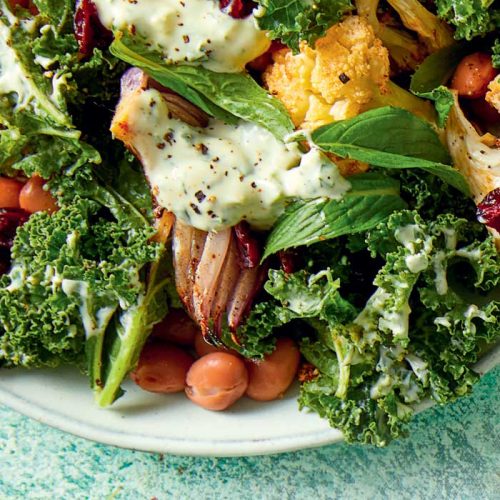
Intermittent fasting is being hailed as the ‘diet’ you’re on when you’re not on a diet. But what does the science reveal? HFG dietitian Brooke Delfino checks out the latest research.
Once the preserve of religious orders, fasting is the latest nutrition buzzword. You’ve probably heard of the 5:2 diet, and now fasting protocols like 16:8 and 18:6 are popping up. But do they live up to the hype?
HFG is no fan of drastically restricting food intake to lose weight. But no single approach suits all, and intermittent fasting offers a way of eating that can work for some people. With adherents claiming fasting can spur weight loss, prevent disease and promote heart health, we examine the evidence.
Not what, but when
Fasting for health reasons, rather than for religious beliefs, started as a way to improve longevity. These days, intermittent fasting is gaining popularity as a weight management tool, but it’s not a diet. That’s because instead of dictating what foods you should and shouldn’t eat, intermittent fasting determines when you should eat and when to abstain — and no food is ever off limits.
Part-day fasting is another name for the 16:8 intermittent fasting method. Quite simply, it involves fasting for 16 hours of the day, then eating within an eight-hour window. And within that eating period, you eat the foods you would normally eat. So, unlike the 5:2 method, where food is heavily restricted to between 500 and 800 calories on two days of the week, 16:8 places no restrictions around intake. What’s even better is that most of the hard work of fasting is done while you’re asleep!
Benefits of part-day fasting
It’s reasonable to have some scepticism about this way of eating, but some of its reported benefits include:
- Flexibility to suit individual lifestyles
- Helps to reduce appetite and improve enjoyment of food
- Assists with weight loss, while retaining muscle mass
- Reduces the risk of major chronic diseases, including type 2 diabetes and heart disease
- Improves energy levels and productivity.
What the science says
Over the last 15 years, fasting research has mainly focused on what happens when food is restricted for a few hours or days a week — intermittent fasting — rather than sustained periods of prolonged fasting.
While the scientific evidence is still in its infancy, intermittent fasting has been associated with a range of health benefits, including promoting weight loss, reducing inflammation, improving diabetes management and extending your life.
Is intermittent fasting safe?
While prolonged fasting can sometimes cause headaches, low energy, muscle loss and weakness, intermittent fasting is generally without risk. Having said that, there are certain people who should definitely leave it in the ‘no-go’ basket.
These include:
- People with eating disorders
- Pregnant women
- Breastfeeding women
- People with very high energy needs (such as athletes)
- Young children
- People with certain medical conditions.
- If you have diabetes, always ask your doctor for advice before fasting.
Fasting and weight loss
Intermittent fasting helps to reduce your overall kilojoule/calorie intake, so you’re likely to lose weight. According to Jaime Rose Chambers, an accredited practising dietitian and author of 16:8 Intermittent Fasting, intermittent fasting can help with visceral (belly) fat loss while sparing muscle mass.
“This is unusual for most weight-loss methods, and important for long-term weight management, as higher muscle mass helps to burn more kilojoules at rest,” Chambers says.
“When intermittent fasting was put up against a traditional kilojoule-controlled diet, in many cases intermittent fasting gave the same or better results, particularly in overweight and obese people,” she says.
Importantly, intermittent fasting seems to teach people that it’s okay to occasionally feel hungry. In fact, most people report their hunger levels decline over a few weeks, which makes following intermittent fasting much more sustainable in the long term. A fear of hunger can sometimes cause problems for people who need to lose weight, and is also sometimes associated with overeating. But those who fast intermittently say knowing they’ll have food at a certain time relieves this fear and anxiety.
Fasting and diabetes
There’s now increasing evidence to indicate that intermittent fasting has potential benefit for people with diabetes, and that it can be done safely.“Intermittent fasting may help reduce blood glucose and insulin levels,” Chambers says.
“The most significant impact may be on people with pre-diabetes, where studies have shown that insulin resistance reduced by up to 45 per cent. Non-diabetic overweight adults also recorded a 20 per cent reduction in their insulin levels,” she adds.
Fasting and gut health
Our gut bacteria seem to like short periods of fasting. Most of the research is animal-based, but some recent human trials show fasting can decrease the bacteria associated with inflammation and increase bacterial diversity — two important features when improving gut health.
Time-restricted feeding has a lot do with changes to gut bacteria. Gut bacteria are affected by day-night body patterns or circadian rhythms.
If your body has periods without food overnight, this can help re-establish disrupted circadian rhythms and improve gut health.
Having a decent overnight fast may therefore be a great way to start giving your gut bacteria a helping hand. A 10 to 12-hour overnight period, say 7pm to 7am, where no food is consumed is actually a traditional way of eating. After all, that’s the meaning behind the word ‘breakfast’: to break the fast.
What does an intermittent fasting day look like?
The 16:8 fasting method involves fasting for 16 hours of the day — most of which is when you are asleep — then eating within an eight-hour window of time. The timing of those eight hours can be whenever suits you best. The reason this is one of the most successful fasting methods is that many people are already fasting for 10 to 12 hours without even realising. To extend your fasting window, you might start by pushing breakfast back a little later and bringing dinner forward. Take a look at the intermittent fasting plan suggestions and consider if one of them fits into your lifestyle.
Fasting and brain health
Memory and mood can also benefit from fasting.
“Fasting can help to protect the brain from neurodegenerative diseases, such as Alzheimer’s and Parkinson’s, by ‘shocking’ the brain into create new neurons,” explains Chambers.
“These new neurons are more resistant to plaque accumulation, which is related to the progression of neurodegenerative diseases. Fasting may also improve memory and mood by stimulating the growth of new neurons and strengthening neural connections in the brain.”
Fasting and heart health
Fasting might also benefit your heart. “Fasting has been shown to help reduce ‘bad’ cholesterol levels and blood pressure, reducing your risk of heart disease,” says Chambers.
“Research shows fasting can reduce triglycerides by up to 25 per cent over 12 months. It also revealed a reduction in systolic blood pressure [the pressure in your blood vessels when your heart beats] over three months.”
16:8 part-day fasting meal plans
Option one
Eating window: 7am–3pm
Best for: Breakfast-lovers, early exercisers and people who don’t eat dinner as a family in the evening.
Break the fast at 7am
Breakfast
Bowl of porridge or overnight oats topped with berries & nuts
Morning tea
170g tub of reduced-fat plain yoghurt & sliced banana
Early lunch
Avocado, cheese and tomato on 2 slices grainy toast, plus extra chopped veggies
Late lunch
Homemade chicken and vegetable curry on a bed of brown rice
Piece of fruit
Begin fasting at 3pm
Option two
Eating window: 10:30am–6:30pm
Best for: Busy morning people, breakfast-skippers and people who like to eat dinner early.
Breakfast
Black coffee or green tea and water
Break the fast at 10.30am
Late breakfast
Poached eggs on 2 slices grainy toast with avocado, mushrooms, tomato and spinach
Cappuccino
Lunch
Leafy green salad with tuna, roasted sweet potato & feta
Afternoon tea
Fruit, handful of nuts & a few squares of dark chocolate
Dinner
Tofu/chicken & vegetable stir-fry with steamed Asian greens and brown rice
Begin fasting at 6.30pm
Option three
Eating window: 12pm–8pm
Best for: Breakfast-skippers, afternoon/evening exercisers and people who like to eat out socially or eat later.
Breakfast
Black coffee and water
Morning tea
Green tea and water
Break the fast at midday
Lunch
Wholegrain bread sandwich with a filling of avocado, salad and smoked salmon
Afternoon tea
Fruit, handful of nuts and cappuccino
Dinner
Wholemeal pasta topped with bolognese sauce & parmesan, plus a side salad with olive oil dressing
Supper
170g tub of reduced-fat plain yoghurt with berries
Begin fasting at 8pm
7 steps for fasting success
1. Be realistic
It’s probably not a good idea to fast on days when you are attending a social event or are expecting visitors.
2. Plan ahead, but be flexible
You don’t need to fast on the same days every week, but doing so can make it easier to get yourself into a routine. Start by planning a week at a time, and decide how fasting can fit into your schedule.
3. Drink enough water
Aim to drink between eight and 10 glasses every day, if not more, to stay well hydrated.
4. Eat lean protein
Make sure your meals contain protein sources, such as eggs, beans and legumes, to fill you up and help build muscle.
5. Tune into your hunger signals
Consider if it’s really hunger that’s making you want to snack. It might actually be boredom.
6. Don’t rely on coffee
If you need a quick energy hit, instead of another coffee, go for a brisk walk around the block to get your blood pumping.
7. Don’t ‘overcompensate’
On non-fasting days, eat sensibly instead of bingeing on high-kilojoule foods. Remember, moderation is the key!
Article sources and references
- Carter et al. 2016. The effects of intermittent compared to continuous energy restriction on glycaemic control in type 2 diabetes; a pragmatic pilot. Diabetes Res Clin Pract. 122: 106–12.https://pubmed.ncbi.nlm.nih.gov/27833048/
- Chambers, JR. 2021. The 16:8 Intermittent Fasting Lifestyle Plan. Pan Macmillan Australia. Fontana L & Partridge L. 2015. Promoting health and longevity through diet: From model organisms to humans. Cell. 161: 106–18.https://www.panmacmillan.com.au/9781760985158/
- Gabel et al. 2020. Effect of time restricted feeding on the gut microbiome in adults with obesity: A pilot study. Nutr Health. 26(2): 79–85.https://pubmed.ncbi.nlm.nih.gov/32228124/
- Headland et al 2016. Weight-loss outcomes: A systematic review and meta-analysis of intermittent energy restriction trials lasting a minimum of six months. Nutrients. 8: 354.https://pubmed.ncbi.nlm.nih.gov/27338458/
- Hoddy et al. 2014. Meal timing during alternate day fasting: Impact on body weight and cardiovascular disease risk in obese adults. Obesity. 22: 2524–31.https://pubmed.ncbi.nlm.nih.gov/25251676/
- Longo VD & Mattson MP. 2014. Fasting: Molecular mechanisms and clinical implications. Cell. 19: 181–92.https://www.ncbi.nlm.nih.gov/pmc/articles/PMC3946160/
- Longo VD & Panda S. 2016. Fasting, circadian rhythms, and time-restricted feeding in healthy lifespan. Cell Metabolism. 23: 1048–59.https://www.ncbi.nlm.nih.gov/pmc/articles/PMC5388543/
- Mattson et al. 2017. Impact of intermittent fasting on health and disease processes. Ageing Res Rev. 39: 46–58.https://pubmed.ncbi.nlm.nih.gov/27810402/
- Patterson RE & Sears DD. 2017 Metabolic effects of intermittent fasting. Annu Rev Nutr. 378: 371–93.https://pubmed.ncbi.nlm.nih.gov/28715993/
www.healthyfood.com










